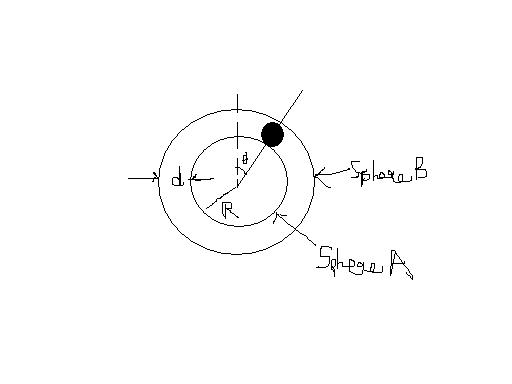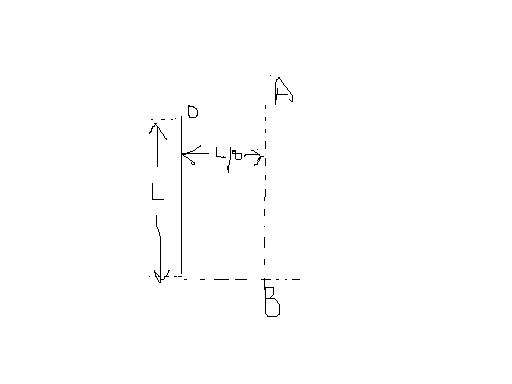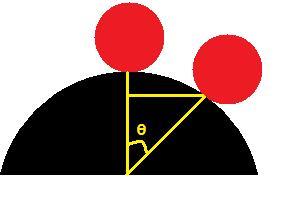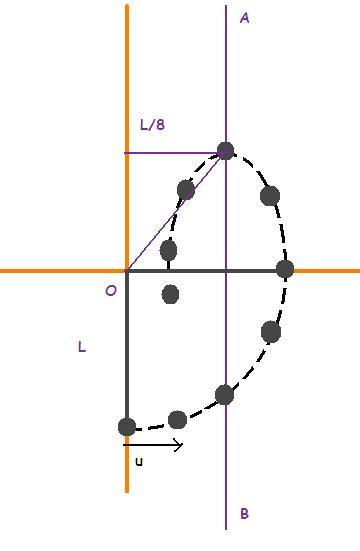@ Varun, when the moderators will see then they will do.
karma karte chalo, phal ki chitna mat karo vats ( Duty without desires) [3][3]
!. A spherical ball of mass m is kept at the highest pt. in the space b/w 2 fixed , concentric spheres A and B ( see fig. ) . The smaller sphere A has a radius R and the space b/w 2 spheres has a width d. The ball has a diameter very slightly less than d. All surfaces r fricnless. The ball is given a gentle push ( towards the rite in the fig. ). The angle made by the radius vector of the ball with the upward vertical is denoted by theta (shown in the fig.)
Let Na and Nb denote the magnitudes of the normal reacn forces on the ball exerted by the sphere A and B , respectively. Sketch the variations of Na and Nb as funcns of cos theta in the range 0 less than equal to theta less than equal to pi.
oooffff.............such a long quesn:O
2. A particle is suspended vertically frm a pt. O by an inextensible massless string of length L . A vertical line AB is at a distance L/8 frm O as shown. The object is given horizontal vel. u . At some pt. , its motion ceases to be circular and eventually the obj. passes thru the line AB . At the instant of crossin AB , its vel. is horizontal . Find u.
@ Varun, when the moderators will see then they will do.
karma karte chalo, phal ki chitna mat karo vats ( Duty without desires) [3][3]
yeah actually i got irritated yesterday only i solved the nswer n when i was posting it so it logged off n then sked me to sign me again n i lost the answer so irritated today i wrote the answer like this but anyway
cheers!!!!!!!!!!!
@ varun, please make use of greeks while posting answer, it will make the post look better and more understanding. Please don't be offended
the 2nd sum is very easy
1st the string will slack after moving 90 (all angles are with respect to the vertical )
so obviosuly the ball will crosss L/8 twice one when its in circular motion other when its not..
let it become slack at an angle 90+@
at that point
mgcos@=mv^2/l
so v^2=lgcos@
the hieght above the initial point is L(1+cos@)
and the horizontal distance is Lsin@
1/2mv^2=mgh=1/2mu^2
v^2+2gh=u^2
so
(3cos@+2)lg=u^2
now since it becomes slack it will continue its motion now in the projectile sense
since at any pnt of time the vel is tangent to the string so
v(y)=vsin@
v(x)=vcos@
v(y) will be 0 at time
vsin@/g
and at that time distance travelled from the pnt of slacking will
be v^2cos@sin@/g =Lcos^2sin
now the distance from the pnt of suspension wil
be Lcos@-Lcos^2sin =l/8
solving we get sin@=1/2
and therefore we get the answer....
since the ball is a bit small in size as compared to the tunnel,
either the ball touches the lower surface or the upper surface...
thus at a time either of them or both of them can be zero but both cannot have non-zero value...
value of normal reactions differ as i gave (i think)
the lower N is created by component of weight minus centrigugal force
the upper N is provided by only centrifugal force...
abt the first question first steps are easy
mg(R+d/2)[1-cos@)=1/2mv^2
form there we know the centiripital force acting on it mv^2/r
so in the end
mgcos@-n1+n2=mv^2/r
now whats the relation between N1 and N2
thats the doubt where n1 is by the lower and n2 is by the uppper.......... i cant get that....
but since there r no other clue
i am assuming n2=0 since the sphere doesnt touch the other sphere
no subhomoy i think ur naswers wrong
I have a few problems....
How can the velocity of the ball be directed towards horizontal if its postion is already at an acute angle with the vertical?......also you said that the string is inextensible, that means horizontally directed velocity can be achieved only at initial position and at 180° with the initial position....
But the problem seems interesting.....can you please post it again ? Thanks..
!. A spherical ball of mass m is kept at the highest pt. in the space b/w 2 fixed , concentric spheres A and B ( see fig. ) . The smaller sphere A has a radius R and the space b/w 2 spheres has a width d. The ball has a diameter very slightly less than d. All surfaces r fricnless. The ball is given a gentle push ( towards the rite in the fig. ). The angle made by the radius vector of the ball with the upward vertical is denoted by theta (shown in the fig.)
Let Na and Nb denote the magnitudes of the normal reacn forces on the ball exerted by the sphere A and B , respectively. Sketch the variations of Na and Nb as funcns of cos theta in the range 0 less than equal to theta less than equal to pi.
The ball will lose contact with the inner sphere when N=0
or 3cos θ - 2 = 0 ( hope you know this value is N)
θ=cos-1(2/3)
after this it make contact with the outer sphere and the normal reaction starts acting towards the centre. Thus for
θ <= cos-1 (2/3)
Nb = 0
Na =(3cosθ-2)
and for θ>= cos-1(2/3)
Na=0 and Nb=mg(3cosθ-2)
fine thnx....:)
i was arguing with my frnd and he was sayin that for sphere A N wud be const. and equal to mg......which wud dec down to 0 at cos theta = 2/3.....
yeah!!
down sphere will vary as N=mg cos\theta - \frac{2mg[(R+d)-(R+\frac{d}{2})cos\theta ]}{R+\frac{d}{2}} before losing contact...
and then upper normal reaction varies as N=\frac{2mg[(R+d)-(R+\frac{d}{2})cos\theta ]}{R+\frac{d}{2}} after losing contact...
ok fine
now for sphere A the normal reacn wud be varying since as the angle varies , so the vel.varies(increases gradually) and hence the centrifugal force varies......
am i rite??

in this the ball slopes down and at a point achieves enough velocity si that it can take a form of projectile and leave the surface ...
similarly in the problem, we have to find the angle and for any angle less than the found angle, N for lower surface is non-zero
for the rest of the time, the N of outer surface is non zero!!
@evil inside:
the trajectory is as i show it in the diagram:

in the 4th quadrant the motion will be circular but in the first quadrant it will become projectile!
the particle crosses the line AB at it's maximum height!!! :)
using kinematics the rest problem will have to be solved which will be easy..:)